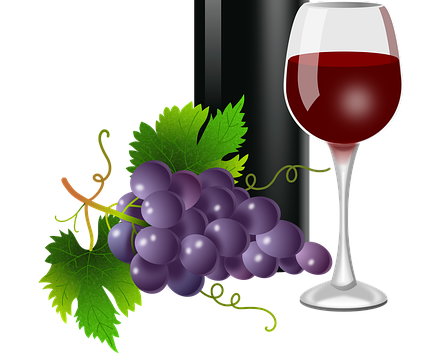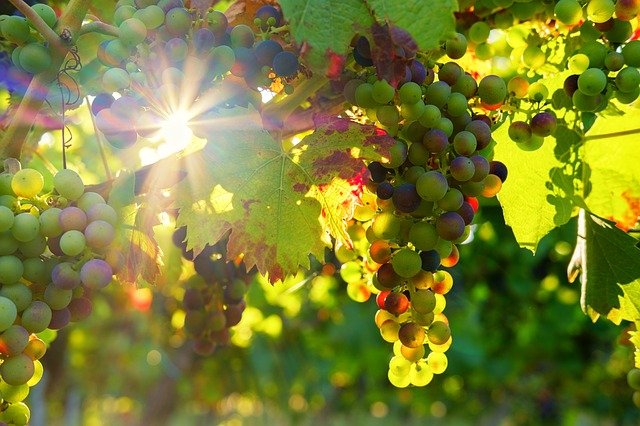El vino es una bebida popular en todo el mundo. Pero, ¿cómo se hace realmente el vino?
La historia de la uva
La uva ya era cultivada y convertida en vino por los romanos en la antigüedad. Sin embargo, las primeras vides se cultivaron probablemente en Persia o en el actual Irán. Con el tiempo, sin embargo, el cultivo de la uva se extendió también a Europa, donde fue especialmente popular en Italia y Francia. En Alemania, la uva no se cultivó hasta el siglo XVI, siendo las variedades Riesling y Spätburgunder las más conocidas. Hoy en día, la uva es una de las variedades frutales más cultivadas del mundo y se utiliza tanto en fresco como transformada en vino, zumo o vinagre. Las distintas variedades difieren en tamaño, color y forma. Las variedades de uva más conocidas son Chardonnay, Merlot, Pinot Noir y Sauvignon Blanc.
¿Cuándo está madura la uva?
La vendimia es un asunto delicado. Porque las uvas tienen que cosecharse en el momento adecuado para que luego se conviertan en un buen vino. ¿Pero cuándo está madura la uva? Esta pregunta no puede responderse de forma general, porque depende de varios factores. En primer lugar, por supuesto, la variedad es decisiva, pero también la ubicación y el clima. El periodo de maduración comienza sobre todo en agosto o septiembre y termina en octubre o noviembre. Durante este tiempo, el viticultor debe observar atentamente la evolución de las uvas y decidir cuándo es el momento de cosecharlas.
¿Cómo se convierte la uva en vino?
Una vez recogidas las uvas, primero se lavan y luego se fermentan en un tanque de fermentación. Durante este proceso, los azúcares se transforman en alcohol. Las uvas se remueven regularmente con un palo de madera para evitar la formación de moho en la superficie. Al cabo de unas dos semanas, el proceso de fermentación ha concluido y el vino puede embotellarse. Antes, sin embargo, se filtra para que ningún sedimento acabe en la botella de vino. El vino se embotella en botellas de Burdeos o de Borgoña. A continuación, el vino madura en una bodega donde se almacena hasta su degustación.
La vinificación, un arte en sí misma
El siguiente paso en la producción de vino es el prensado. Este proceso consiste en prensar las uvas para extraer el zumo. A continuación, el zumo se almacena en barricas o depósitos y se fermenta, dando lugar al vino. El prensado es un paso crucial en la elaboración del vino, ya que determina la cantidad de mosto (o zumo de uva) que se extrae de las uvas. Si se exprime demasiado mosto de las uvas, puede resultar un vino blando y plano. Sin embargo, si se exprime demasiado poco mosto de las uvas, puede resultar un vino duro y astringente. Hay diferentes tipos de prensado, cada uno con sus propias ventajas e inconvenientes. Los métodos de prensado más utilizados son el neumático y el hidráulico. El prensado neumático es el método más rápido y eficaz de prensado. Este método utiliza aire comprimido para exprimir el zumo de las uvas. El prensado hidráulico es más lento que el neumático, pero también es muy eficaz. Este método utiliza la presión del agua para exprimir el zumo de las uvas.
El viñedo – La base del buen vino
El viñedo es la base del buen vino. Es el lugar donde crecen y maduran las uvas. La calidad del vino depende en gran medida de las condiciones del viñedo. El clima es un factor esencial que influye en la calidad del vino. No debe estar demasiado caliente ni demasiado frío. Lo ideal es un clima templado con suficiente sol y lluvia. Los suelos del viñedo deben estar bien drenados para que el agua pueda escurrir bien. También deben ser ricos en nutrientes para que las uvas puedan prosperar. Las vides deben estar bien espaciadas para que reciban suficiente aire y luz. Los zarcillos de las vides deben retirarse con regularidad para que no se enreden y se resienta su calidad.
Conclusión
En resumen, la uva se convierte en vino porque su alto contenido en azúcar y su variedad de sabores la hacen especialmente adecuada para ello. Estas características lo convierten en un producto de partida ideal para la viticultura. Las uvas se cosechan, se prensan y se fermentan. Este proceso crea el vino que a todos nos gusta beber.


Comentarios recientes